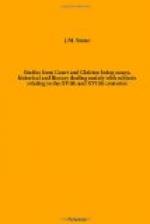A fragment of another Ms., marked as missing in Planta’s catalogue, has found its way to the Bodleian library. It consists of ten folios of the Life of St. Basil, and a note by Hearne says that it came from a Cottonian Ms.
Grand and imposing as the Cottonian library still is, it is painful to consider how incomparably finer it must have been during the life of its founder, before it suffered from the ravages of the fire, and from the carelessness or dishonesty of so many borrowers. Sir John Cotton avowed that many books lent to Selden were never returned; the Duke of Buckingham was also guilty in the same respect. A manuscript now in the Bodleian library (Barlow 49) was borrowed from the Cottonian by Dr. Prideaux, and never returned. It was afterwards exposed for sale at Worcester, and bought by Dr. Barlow, who presented it to the Bodleian. Parliamentary rolls often suffered a like fate, and instances of similar losses could be largely multiplied. The loss of the Utrecht Psalter is, however, perhaps the most grievous that the library has sustained from borrowers.
Some of the manuscripts, injured by the fire at Ashburnham House, were further mutilated by another fire which occurred on the premises of a bookbinder on the 10th July 1865.
In 1753 the government purchased the large Natural History and Art Collection of Sir Hans Sloane, together with a library of 50,000 volumes, which were deposited in Montague House, Bloomsbury, on the site of the present British Museum Buildings. Hither the Cottonian and Royal libraries were brought, forming, together with the Sloane manuscripts, the nucleus of the great national collections of which we are justly proud, and which, under their present efficient and courteous management, are rendered so useful to students.
The British Museum was formally opened to the public at Montague House in 1759. But it grew so rapidly that soon more space was needed, and in 1823 the eastern wing of the present building was erected to receive the library of George iii. presented to the museum by George iv. The whole building was completed in 1847.
V. THE ROYAL LIBRARY
The Royal library is in many ways the most splendid of our national manuscript collections. Had it been fortunate enough, like the Harleian library, to number a Wanley among its custodians and biographers, the history of its formation would read like a fairy-tale. But, unhappily, we have to depend for our chief data on what Casley, the “dry as dust” pay excellence of librarians could tell us, and though his knowledge of the age of MSS. was admirable, he was remarkably uncommunicative regarding their pedigree, meagre in his descriptions, and apparently insensible to paleographic beauty. There is scarcely, in the whole British Museum, a less satisfactory book than his catalogue of the Royal library. Thus, the student is hampered by the want of a guide, and must hew paths for himself through the luxuriant growth and accumulations of many centuries. In point of mere size, the Royal library ranks third among the four great collections acquired by the British Museum at the time of its foundation—the Harleian numbering 7639 MSS.; the Sloane, 4001; the Royal, 1950; the Cottonian, 900.




